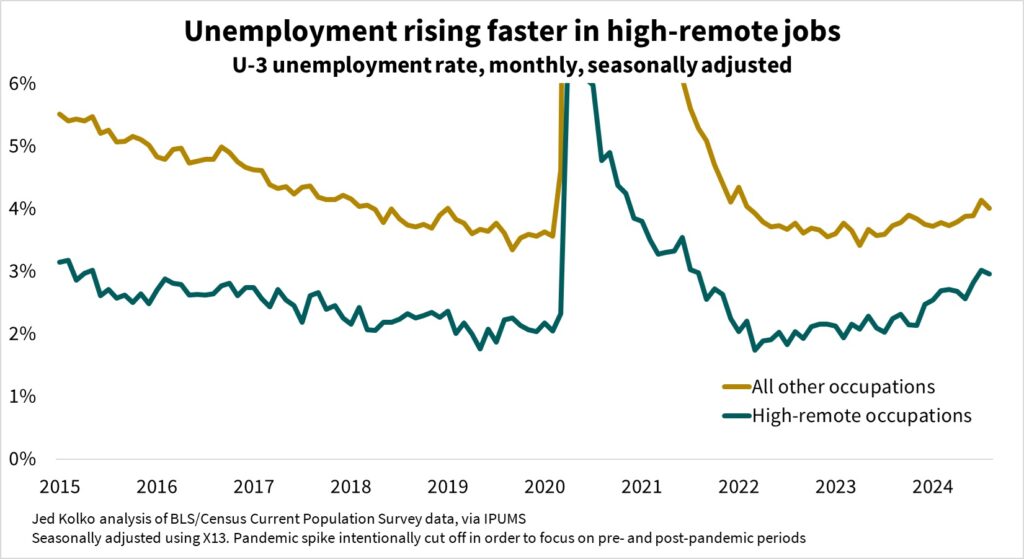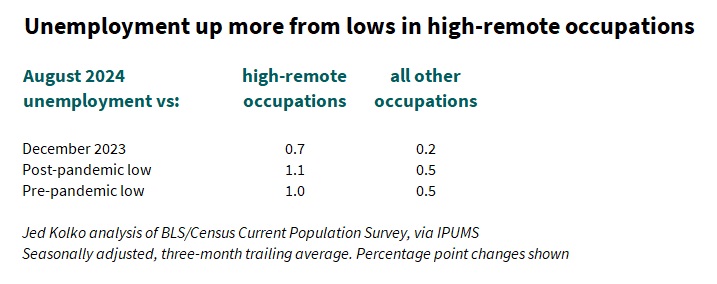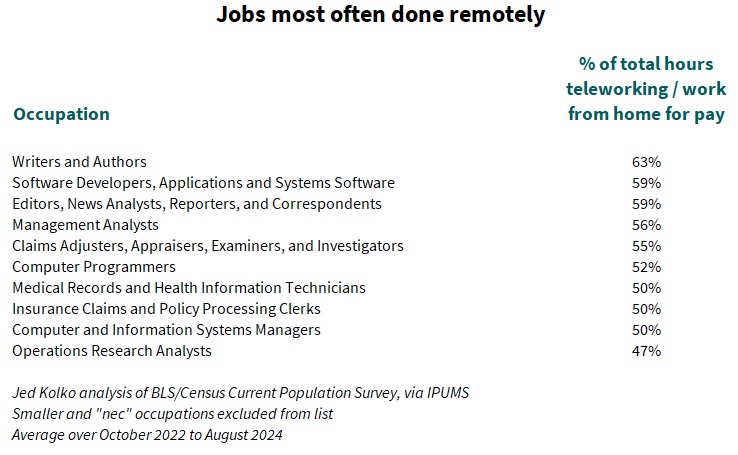The recent rise in unemployment is steeper in occupations where remote work is more widespread. A continued rise could shift bargaining power towards employers who want workers to return to the office.
Last week Amazon announced that its workers would need to work in person five days a week starting in January. Since tech has been the sector most open to remote work, and Amazon is such a dominant tech company, Amazon’s announcement prompts the question: could remote work, after jumping during the pandemic and holding steadily high since, go into reverse?
Predictions about remote work tend to be grounded in structural arguments about its impact on productivity, flexibility, supervision, mentoring, and organizational culture. But the cyclical ups and downs of the labor market could matter, too. Working remotely is a perk, and workers have more bargaining power over perks (and everything else) when the labor market is tight. One academic study found that remote work was more widespread in states with tighter labor markets. In the emergence from the pandemic in 2022 and 2023, unemployment reached historic lows, giving workers bargaining power to resist calls to return to the office. Times might now be changing.
The Amazon announcement follows a period of rising unemployment, from a very low level of 3.4% in April 2023 to a still-low-by-historical-standards level of 4.2% in August 2024. However, the recent increase in unemployment has been sharper for people in occupations where remote work is more common.

In August 2024, unemployment was 0.7 percentage points higher than in December 2023 in high-remote occupations, where people telework or work from home at least 25% of the time. In all other occupations, unemployment rose just 0.2 points from December 2023 to August 2024. Unemployment in high-remote occupations in August 2024 was 1.1 points above its post-pandemic low and 1 point above its pre-pandemic low, and is at its highest level since mid-2015 (excluding of course the pandemic spike in 2020 and 2021). In contrast, unemployment in all other occupations is just half a point above its post- and pre-pandemic lows, and is back up only to its 2018 level.

The rise in unemployment for high-remote occupations is more relevant for bargaining over remote work than the overall unemployment rate is. Remote work is concentrated in specific sectors. Just a quarter of jobs are in occupations where people work remotely at least 25% of the time. These occupations tend to be in tech, media, and business & financial operations. In a few occupations, people work remotely at least half the time. Of course, for many occupations telework is rare or nonexistent, like food prep, building maintenance, construction, mining, and transportation – changes in the unemployment rate in these sectors probably won’t have any effect on the prevalence of remote work.

Does the rising unemployment rate in high-remote occupations mean that Amazon’s new return-to-office policy is a bellwether? Hard to say. There’s no way to guess how much unemployment in high-remote occupations would have to rise to cause a significant decline in remote work. The post-pandemic period is too short to extrapolate from, and too much has changed from the pre-pandemic period to draw inferences about remote work from patterns in those days. Further, the relationship between remote work and the labor market is complicated: remote work has raised employment among people with disabilities and with caregiving responsibilities, for example – making it hard to tease apart and quantify the link between employment rates and remote work. All that said, the unemployment rate in high-remote occupations will be a number to watch.
Note: all data are from BLS/Census Current Population Survey monthly microdata, via IPUMS, seasonally adjusted by the author using X-13. Occupations are classified as high-remote based on the share of hours worked that were done via telework or working from home for pay over the period October 2022 to August 2024. New labor-force entrants who are unemployed (mostly age 21 and younger) lack an occupation and were excluded from this analysis; their exclusion means that the weighted average of the unemployment rates for high-remote occupations and all other occupations is a few tenths of a percentage point below the published unemployment rate.